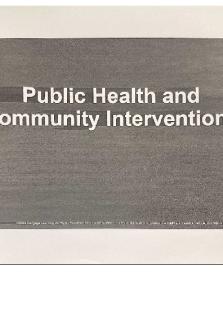a nursing interventions 042421 PDF

| Title | a nursing interventions 042421 |
|---|---|
| Author | Sara Ray |
| Course | Intro Prof Of Nursing |
| Institution | University of Florida |
| Pages | 4 |
| File Size | 99.2 KB |
| File Type | |
| Total Downloads | 91 |
| Total Views | 147 |
Summary
Care map for nursing class. Contains ND/interventions...
Description
Module 03 Assignment- Interventions to Promote an Environment of Safety
Case Study: Mr. Joe Smith, 75-year old man, recently suffered a left cerebrovascular accident. He has right visual field deficits and residual weakness in this right arm and leg. He uses a walker for mobility. He takes Metoprolol for his blood pressure and the physician started him on Coumadin because he has recently been diagnosed with atrial fibrillation.
As a nurse for Mr. Smith, a multitude of nursing interventions must be in place to ensure Mr. Smith’s safety. Nursing interventions need to address visual and mobility concerns. The patient has limited mobility and has residual weakness on the right side of his body. Due to such limitations, Mr. Smith uses a walker to assist him. Safety concerns for mobility are lack of strength and the use of assistive devices. Nursing interventions that can address mobility concerns are: 1. Education and use of assistive devices: The proper use and education of an assistive device is necessary for effectiveness and safety. The patient should be wearing slip-resistant shoes in order to decrease the risk of falls. Mr. Smith should be informed of the proper fitting of the walker and it should not be changed after it was fitted. Mr. Smith should be educated on the proper transfer techniques and proper hand placement to minimize safety concerns. Assistive devices also improve confidence for activities of daily living. 2. Assistance in ambulation: Mr. Smith’s limited mobility curtails his ability to properly move and be active. Because of his right sided weakness, assistance
with ambulation may be necessary. The use of a transfer belt may be necessary to help Mr. Smith to get to his walker without the risk of a fall. 3. Promoting independence of ADL’s: Due to Mr. Smith’s left CVA, his activities of daily living may be affected. Approximately 75% of patients with a stroke have difficulties with their activities of daily living (Kim et al., 2014). Kim et al, states if a stroke occurs in an individual after the age of 65, 80% of them will have a chronic disability (2014). Mr. Smith may be experiencing poor coordination or difficulty initiating movements. Mr. Smith may have to relearn certain tasks or learn how to adjust how he does certain activities. The nurse shall support independence of ADL’s and help the patient adjust if an ADL has to be modified. Mr. Smith has right visual deficits and is on Metoprolol for his blood pressure and Coumadin for atrial fibrillation. Nursing interventions that can address sensory and perception
concerns are: 4. Medication education: Medication education is vital for patients to understand the effects of their medications and leads to improved adherence to their medication. The elderly are at higher risk of polypharmacy which may present with a higher risk of nonadherence (Golchin et al., 2015). It is important that Mr. Smith understands what each medication is treating and the proper dosages. Adherence also increases when a simple schedule is created for the patient.
5. Visual assessment and orientation to room: Because Mr. Smith has a visual deficit it is important to assess visual acuity and visual fields. Mr. Smith should be oriented to how furniture is arranged, where the washroom is, and where specific items are. Mr. Smith should also have personal belongings and a call light within reach.
Reference:
Golchin, N., Frank, S. H., Vince, A., Isham, L., & Meropol, S. B. (2015). Polypharmacy in the elderly. Journal of research in pharmacy practice. https://doi.org/10.4103/2279-042X.155755
Kim, K., Kim, Y. M., & Kim, E. K. (2014). Correlation between the Activities of Daily Living of Stroke Patients in a Community Setting and Their Quality of Life. Journal of physical therapy science. https://doi.org/10.1589/jpts.26.417...
Similar Free PDFs

a nursing interventions 042421
- 4 Pages

Depression Nursing Interventions
- 4 Pages

Chapter 09 Designing Interventions
- 12 Pages
Popular Institutions
- Tinajero National High School - Annex
- Politeknik Caltex Riau
- Yokohama City University
- SGT University
- University of Al-Qadisiyah
- Divine Word College of Vigan
- Techniek College Rotterdam
- Universidade de Santiago
- Universiti Teknologi MARA Cawangan Johor Kampus Pasir Gudang
- Poltekkes Kemenkes Yogyakarta
- Baguio City National High School
- Colegio san marcos
- preparatoria uno
- Centro de Bachillerato Tecnológico Industrial y de Servicios No. 107
- Dalian Maritime University
- Quang Trung Secondary School
- Colegio Tecnológico en Informática
- Corporación Regional de Educación Superior
- Grupo CEDVA
- Dar Al Uloom University
- Centro de Estudios Preuniversitarios de la Universidad Nacional de Ingeniería
- 上智大学
- Aakash International School, Nuna Majara
- San Felipe Neri Catholic School
- Kang Chiao International School - New Taipei City
- Misamis Occidental National High School
- Institución Educativa Escuela Normal Juan Ladrilleros
- Kolehiyo ng Pantukan
- Batanes State College
- Instituto Continental
- Sekolah Menengah Kejuruan Kesehatan Kaltara (Tarakan)
- Colegio de La Inmaculada Concepcion - Cebu












